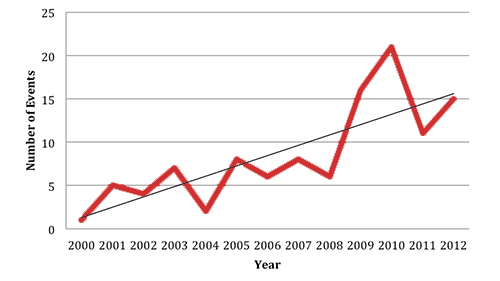

The Occupational Safety & Health Administration Section (OSHA) of the United States Department of Labor sets workplace regulations to ensure safe working environments for employees. One of the regulations under the General Duty Clause, Section 5 (a)(1) states, “Each employer shall furnish to each of his employees, employment and a place of employment which are free from recognized hazards that are causing or are likely to cause death or serious physical harm to his employees”. Violations of the OSHA regulations can result in employers receiving fines and will likely involve a civil lawsuit. Recent court rulings relative to liability lawsuits have shown that active shooter scenarios have become more prevalent and are now considered a “recognizable hazard” to employees. This ruling by the court puts the burden on employers to provide training to their employees on how to recognize indicators of potential active shooters as well as how to respond when an active shooter situation occurs. If the training is not provided, it opens the door for a civil liability against the business.
Active Shooter Events by Year

The Census of Fatal Occupational Injuries (CFOI) conducted by the Bureau of Labor Statistics (BLS) provides an annual count of fatal work injuries in the United States, including homicides. From 2006 to 2010, an average of 551 workers per year were killed as a result of work-related homicides. In 2010 (the last year for which final data are available), CFOI reported a total of 518 workplace homicides, or 11 percent of all fatal work injuries that occurred that year. A total of 77 of those were multiple-fatality homicide incidents in which two or more workers were killed, including 69 homicides and 8 assailant suicides, all of whom were in work status at the time of the incident. Shootings accounted for 78 percent of all workplace homicides in 2010 (405 fatal injuries). More than four-fifths (83 percent) of these workplace homicides from shootings occurred in the private sector, while only 17 percent of such shootings occurred in government.

The General Duty Clause, *Section 5(a)(1) of the Occupational Safety and Health Act (OSHA) of 1970, requires employers to provide their employees with a place of employment that “is free from recognizable hazards that are causing or likely to cause death or serious harm to employees.” The courts have interpreted OSHA’s general duty clause to mean that an employer has a legal obligation to provide a workplace free of conditions or activities that either the employer or industry recognizes as hazardous and that cause, or are likely to cause, death or serious physical harm to employees when there is a feasible method to abate that hazard.
*Section 5(a)(1) of the Occupational Safety and Health Act (OSHA) of 1970, re

In a July 2, 2013 court decision from Hennepin County, Minneapolis, MN, the court found fault with the employer for negligence and failing to train their employees. District Court Judge Denise Reilly allowed two negligence counts to proceed against the company, Accent Signage. The civil case was brought before the courts by the victims’ family members in response to an active shooter incident at a place of business. This incident occurred as the gunman, Andrew Engeldinger, walked into his place of employment on September 27, 2012 with a pistol. Once inside, Engeldinger shot and killed numerous individuals before taking his own life.Court rulings like the one above places the liability on the employer to train their employees to recognize the indicators of the potential active shooter and how to respond when they are faced with an actual active shooter incident.
The charges basically follow the OSHA guidelines set forth under the “General Duty Clause” that the employer needed to make training available and reasonable safeguards to be put in place. One of the victims, Beneke’s family sued the Accent Signage and Engeldinger’s estate in February. Releasing the shooters estate from liability and holding the company responsible is a new shift in thoughts regarding pre-planning and prevention. Engeldinger shot and killed Beneke, and four other employees and co-workers along with a UPS deliveryman before committing suicide on September 27, 2012.
